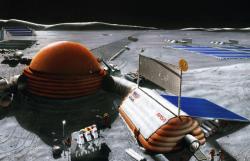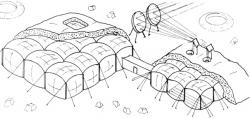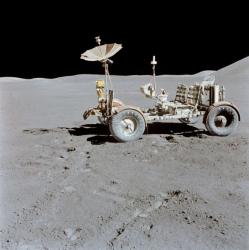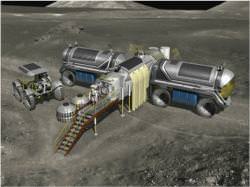Plans are afoot to build a manned base on the Moon. As you probably would have guessed, there are quite a few hazards and dangers with sending humankind back to establish lunar “real estate”. However, once our intrepid lunar colonists begin to build, the hazards will become less and development will accelerate. This is all very well, but how will we gain that first foothold in the lunar regolith? What will be the best form of habitat structure that can be built to best suit our needs? These questions have some obvious and not-so-obvious answers from the structural engineers already publishing their ideas and building prototypes…
In Part 1 of this mini series on “Building a Moon Base”, some of the dangers facing astronauts and future colonists were outlined. Moon dust could (in all probability) be a health risk, micrometeorites and other speeding projectiles could burst pressurized structures, highly energetic particles from the Sun could irradiate unprotected settlements, damage to machinery could be caused by the vacuum… generally a mixed bag of bad news. But if anything else, we humans have the ability to beat the odds and succeed (if politics and finances allow of course!). This second installment deals with the habitat structural concepts that are being planned to best serve the first, interim and permanent settlements on the Moon when we overcome all the odds.
“Building a Moon Base” is based on research by Haym Benaroya and Leonhard Bernold (“Engineering of lunar bases“)
Many types of structure have been proposed for lunar colonies. However, the main focus for mission planners center on cost and efficiency. Structures fabricated on Earth, while viable, would have to be very lightweight to allow for easy launch out of the Earth’s deep gravitational well. It is generally envisaged that the first bases to be established on the lunar surface will be built on Earth, but once a base of operations is set up, with a contingent of human (and perhaps robot) workers/settlers, local materials should be mined and habitats fabricated in-situ (i.e. built on the Moon). Some of the structures currently being considered are detailed below.
Inflatable designs

Inflatable habitats have always been a favorite, optimizing living space whilst using lightweight materials. As the Moon has no atmosphere (apart from some very tenuous gases being “outgassed” from its surface), any habitat would need to be highly pressurized to simulate the terrestrial atmosphere (to approximately 1 atmosphere or 101,325 Pa) and atmospheric gas quantities. Due to the high forces acting outwards (by the maintained gas pressure), structural integrity of an inflatable can be assured. Assuming the membrane of the inflatable is strong enough, risk of depressurization should be low.
There is however a massive problem with inflatables. In an environment as vacuum-like as the Moon’s, there is little protection from micrometeorites (small, natural space rocks or manmade space debris). Catastrophic depressurization could occur if a high velocity projectile causes a weakness in the membrane. There are some solutions, such as covering the inflatable habitats with a layer of protective regolith, and extensive fail-safes will need to be put in place.

One design (pictured left) uses inflatable “pillows” to create a cuboid shape (rather than the more natural spherical shape). Many of these pillows can be aligned and added on to create a growing settlement. They would maintain their shape by using high-tensile beams to battle against the bellowing membrane material. Protection from micrometeorites and solar radiation would be provided by regolith.
Erectables
Classic erectables have been extensively tested and are an established form of construction. With a focus on ease of assembly, one plan involves sending components into a low Earth orbit. A frame can be easily erected and act as a tetrahedral, hexahedral or octahedral shape by which to base the design of a simple habitat module. Once complete, the module could be shipped to the Moon where it will be controlled into a soft landing. This method uses existing technology and may be one of the more feasible concepts of beginning a Moon base. A basic structure could also be constructed on the lunar surface in a similar fashion.
Local materials
Ultimately, it is hoped that a settlement on the Moon will have an infrastructure capable of mining local materials, fabricating basic quantities and constructing structures with little or no input from Earth. This degree of autonomy would be required if a thriving Moon base is to succeed.
However, to maintain airtightness within the habitats, a new form of concrete would need to be manufactured. All components for a lunar concrete mix can be found on the Moon, although water (and therefore hydrogen) will be at a premium. As the Moon is sulphur-rich, a different type of concrete (minus the need for water) may be created to aid with the construction of arced and domed habitats. Some “geotextiles” may also be made via some advanced refining, creating filmy materials to seal habitat interiors.
Building using locally mined materials will most likely be one of the more advanced methods of construction on the Moon, so in the first stages at least, settlers will be dependent on the Earth for support.
Lava tubes
Ancient lava tubes under the lunar surface exist and may be utilized by colonists. Using natural cavern systems will have many benefits, principally that minimal construction would be required. Many advocates for this plan point out there are too many risks associated with above surface structures, why not use natural shelter instead? Lava tubes may be interconnected, allowing sizeable settlements, also they may be easily sealed, allowing for pressurized habitats. Lunar colonists will also be sufficiently protected from micrometeorites and solar radiation.
Rovers

To bridge the gap between an immobile base and a highly mobile rover, the first base may consist of settlers living and traveling in a roving Moon base. In fact, many designers suggest this solution may be a long-term answer to the future of a colony on the Moon. Unlike the current lunar “Moon Buggy” (pictured), future rovers would be large, accommodating several people within a pressurized cabin. Using rovers as a base may negatively affect processes only static, permanent bases can achieve (i.e. farming activities), but a roving base would allow settlers the freedom to move when and where required around the lunar landscape.
- Building a Moon Base: Part 1 – Challenges and Hazards
- Building a Moon Base: Part 2 – Habitat Concepts
- Building a Moon Base: Part 3 – Structural Design
- Building a Moon Base: Part 4 – Infrastructure and Transportation
“Building a Moon Base” is based on research by Haym Benaroya and Leonhard Bernold (“Engineering of lunar bases“)


Why not underground?
Protection from radiation, meteorites, solar flares, temperature variations etc etc.
Why not?
Will we depend on earth for food or grow our own biosphere? To build soil requires live humus teeming w microbes. Minerals form the base of our enzyme system. Weathering & microbes free minerals from bedrock several feet beneath soil, that or glaciers. Also mites & insects important for breaking down organic detritus; takes much longer w microbes working alone.
No one talks about nitrogen narcosis. Are we confime to pressurized suits? What @ other fauna or flora, could they adapt to expanding gases insides their cells/vacuoles? How many times can we recycle water? Man does not live by cheese alone. Les
I agree with A, underground solves a lot of problems. So why not an inflatable base then bury it?
One major disadvantage to an underground settlement is that suitable locations may not be available where you want your activities to take place. Also to find and explore lava tubes will require a ground presence first. There is no reason a colony could not be made self-sufficient and grow its own food. One concern that I have is lunar quakes, engineers will have to be sure to build structures sturdy enough to withstand them when they occur.
Yes radiation would be a HUGE concern. Underground would be needed, as would digging I am sorry to say. This amount of work calls for a nuclear power plant, or many RTGs (probably a combination). In many ways Mars would be safer, just so much harder to get there.
Why not build a Biosphere in orbit first, or Antartica?
Nitrogen Narcosis, Laszlo?
Isn’t that when your air is under pressure? It isn’t as if the Lunauts would be pressurizing and depressurizing, and the only atmosphere they would experience would be at normal earth pressure. And that goes for plant life and any animals as well. With total recycling going on, there would be a use for everything used up there. That would include sewage, which is already used as fertilizer here on terra firma. That would introduce loads of bacteria and organic matter to any soil. Also, a few million introduced worms and bacteria and they’d multiply til the moon cows came home!
I agree, inflated rooms covered in regolith and dust sound great. Lava tubes would be amazing but unlikely that they could be found in just the right places.
If you want a base at some place that lava tubes aren’t available, how about making a quonsit hut type of structure, burying it under regolith & putting an inflatable inside.
Also, wouldn’t it be better to use less than 1 atm pressure inside the habitats? IIRC the Apollo project used pure O2 at about 1/3 atm pressure.
This would save on importing nitrogen to dilute the oxygen & eliminate problems with the bends in going to lower pressure space suits.
BTW I’ve never be quite sure why 1/5 atm of pure O2 wasn’t used. Since the partial pressure of O2 at sea level is 1/5 atm, I would expect that pressure to.suffice.
# Jim Baerg Says:
February 11th, 2008 at 9:24 am
“BTW I’ve never be quite sure why 1/5 atm of pure O2 wasn’t used. ”
Jim,
Apollo 1, in which astronauts Chafee, Grissom & Young were burned alive in pure Oxegen is the reason.
Homefire
Isn’t it possible that there are already sizeable settlements in these lava tubes, that may be hostile. Undetectable in their safe underground homes?
How about this for temporary habitat? An inflatable dome with self sealing (like aircraft fuel tanks) that, once inflated is covered with reinforcing wire and foamed. The foam may be augmented with local materials. A final covering of regolith would protect against radiation.
The best solution for long term habitat would be underground, with excavation by semi autonomous robots. The robots would be needed anyway to gather raw materials for making solar panels and other amenities. It will certainly make things easier if ice is found around the poles. That will also make low cost fuel available for deep space missions (Mars and beyond).
Some form of mobile facility would be good for exploration, but only a fixed base will offer practical long term self sufficiency.
How about producing building blocks out of compressed or cast regolith. after stacking your blocks to make your structure spray the inside with Rhinoliner or Line-ex type bed liner material. The military is using this to help bomb prof structures in Iraq. The spray on liner both bonds the blocks together it seals in your atmosphere. Add airlocks shipped in from earth or removed from old landers and you have structures that can be built with very little in the way of heavy equipment. It is the adobe village of the 21st century.
To All, I love your comments, but being an Okie I don’t understand much of what your saying. However it’s facinating to read and much more original that Hollywood.
Keep it up.
To Jerry, the Okie
Now that’s somthun, ya’ll Okies mak’n fun from us here in L,A! it’s a switch aint it? cus ya’ll all>……..Of course I’m just kidding!
*************************************************
I have very high levels of confidence, that the result of “Human Curiosity” we will venture into whatever it takes to allow us to continue investigating “The Infinite Universe!” After all, we have no real truthful and factual evidence that let’s us know, where we are and what we are for that matter!
All of the ideas above are very interesting concepts! It’s quite possible that small parts from each concept will provide….maybe little more than clues, that will direct us to the Answer! As long as we continue to explore.
What sickens me is that, at 68 years old, I will be prevented from knowing the answers that will come to be! Even worse, not being able to actually be working in some capacity.
*************************************************
I was born too soon! Damn!
Respectfully,
Gary Searles
when will the subject of electric power be described?
giggity giggity goo alright, underground bases is what I always wanted!
It seems to me the tempature verance between the light side of the moon and the dark could be uesd in some way to allow for energy production.what do you think…